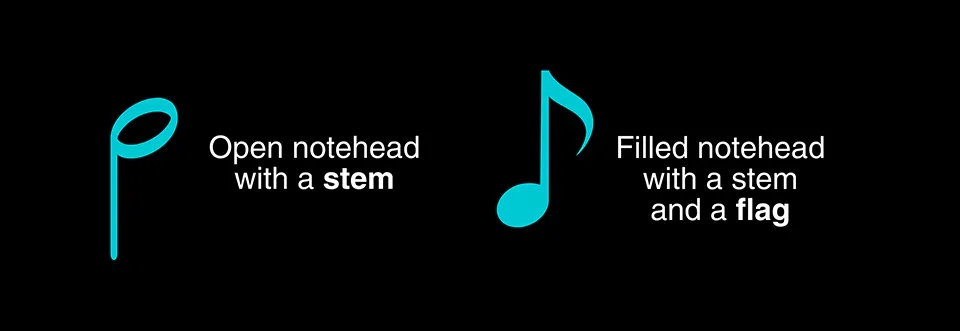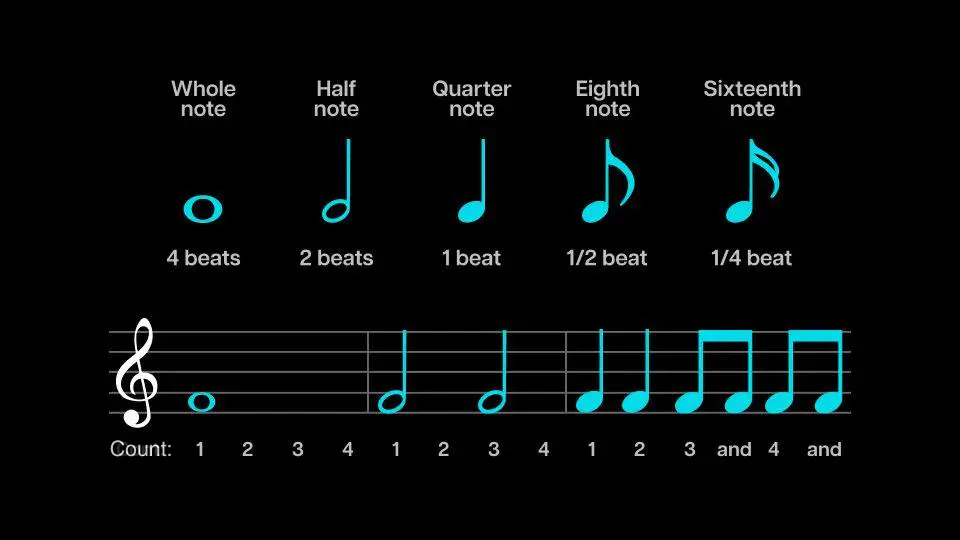DAUS, JOHN KERRY D. (BCAED 2) MUSIC 2
The note parts
Notes are among the main sheet music symbols, and knowing their parts and what they mean is crucial for you to read music notes. These parts include:
- Noteheads;
- Stems;
- Flags.
Noteheads can be filled or open. Filled noteheads indicate shorter note durations, while open ones convey longer durations.

Sheet music, the written form of music notes, may appear very complex to the untrained eye. While reading notes for music is like learning a whole new language, it is actually much less complicated than you may think. This article will discuss how to read music notes.
The stem is a thin vertical line attached to the notehead. It’s positioned on the right side when pointing up and on the left side when facing down. But don’t worry: the direction of the stem does not affect the note. It just enhances readability and reduces clutter in musical notation.
Occasionally, a musical note will also have a flag — a curved stroke attached to the stem.

Staff
The foundation of the written musical language is the staff. It is made up of five lines and four spaces, as seen below. The lines are numbered 1-5 starting from the bottom line. The spaces are numbered 1-4 starting with the bottom space (in between lines 1 and 2).

Clef and Note Names – Each line and space of the staff correspond to a musical pitch, which is determined by the clef. Music notes are named after the first seven letters of the alphabet: A, B, C, D, E, F, G. The two clefs that are primarily used are the treble clef and bass clef.
The treble clef, pictured below, is also known as the ‘G-clef’. This is because the curve in the clef encircles the second line of the staff, which is called a ‘G’ on the treble clef staff. The treble clef is used by instruments that have higher registers, like the flute, violin and trumpet. The higher registers of the piano are notated in the treble clef as well. For beginning pianists, notes on the treble clef staff will be played with the right hand.
The note names on the spaces of the treble clef spell out F-A-C-E.

The Basic Notes:
>Whole note, with the value of 4 beats
>Half note, with a value of 2 beats
>Quarter note, with the value of 1 beat
>Eight notes, with the value of ½ beat
>Sixteenth note, with the value of ¼ beat

Rhythmic notation
Musical notes can have different durations and rests, and rhythmic notation is how the timing of that sequence is communicated. It uses a set of musical symbols to showcase how long to hold each note and when to rest.
Note values
The value of a note is basically an instruction on how long it should last. Besides whole notes, there are half, quarter, eighth, and sixteenth notes, for example.

Take playing the guitar, for instance. In a count of 4, a whole note is played once and held for 4 counts. On the other hand, a quarter note is played 4 times within those same 4 counts.
Rest symbols
The rest symbol sits either above or below the middle line of the staff, depending on the type of rest. Common types are:
- Whole rest: a rectangle positioned below the middle line of the staff, like an upside-down hat;
- Half rest: a rectangle placed above the middle line of the staff, resembling a hat;
- Quarter rest: a symbol shaped similarly to the number 7, reaching above the center line;
- Eighth rest: a sign that also resembles a 7 and sits above the center line, but with an additional flag-like mark;
- Sixteenth rest: a symbol that’s similar to the eighth rest, but with two flag-like marks. This one is also placed above the middle line.

Tips to learn how to read sheet music
Learning how to read sheet music requires a multi-faceted approach. It entails deciphering the visual language and converting it into rhythms and melodies.
That process also means pairing intellectual skills with motor coordination on instruments. Singers, besides maneuvering pitch accuracy and dynamics, have to coordinate sight-reading with vocal apparatus control.
Next, you can find tips and insights on the learning process. These are broken down into beginner, intermediate, and advanced stages.
Beginner stage: foundation, memorization, and rhythm
First, you need to grasp the basics of music notation. This includes the staff, clefs, measures, basic symbols, and time signatures. Start by focusing on small music sections, and work your way up to larger ones bit by bit.
Additionally, it’s a great idea to use mnemonic devices to help remember the details. Those shortcuts include acronyms, acrostics, songs, rhymes, chunking, and association.
After ensuring a strong foundation, move on to the other topics we previously covered:
- Understand and memorize music notes on lines and spaces, including ledger lines. Practicing note identification with flashcards or note-naming apps is one suggestion. Plus, test yourself frequently to reinforce memorization;
- Learn the basic values of whole, half, quarter, and eighth notes, as well as their corresponding rests. You can practice counting rhythms aloud and clapping to internalize the patterns. Here, we strongly recommend using a metronome;
- Begin learning accidentals from common major and minor keys. On that note (pun intended), we suggest practicing the major and minor scales linked to each key signature.
Why learn how to read music?
Serving as a universal language, sheet music is a reliable collaborative tool for musicians. This fosters clear communication, regardless of the instrument or genre.
Learning how to read sheet music sharpens analytical abilities and allows for an in-depth understanding of musical structure. It also favors a more insightful rendition of each song. For composers and arrangers, reading skills are significant, letting them document and communicate musical concepts.
Additionally, musical scores may provide historical and cultural insights. Annotations, marks, contextual factors, and creative influences can all reflect that information. For example, a piece of sheet music for a Bach composition reflects the meticulous use of ornamentation and articulation markings that prevailed in the Baroque period.
Benefits for the brain
Figuring out how to read sheet music doesn’t only sharpen your musical skills. It’s also quite a workout for your brain, offering cognitive benefits that resonate well beyond the notes on the page:
- Memory enhancement: learning to recognize and remember music notation symbols and patterns does wonders for your memory;
- Concentration boost: the intricate task of deciphering music sheets improves focus and nurtures a keen eye for detail;
- Cognitive flexibility: simultaneously reading and playing enhances your brain’s ability to multitask;
- Pattern recognition: this skill is also improved by spotting and interpreting patterns, which benefits other areas of cognition;
- Spatial intelligence: mapping notes and their relationships on staves build up your understanding of space and form;
- Problem-solving: navigating complex musical phrasing strengthens problem-solving skills and promotes creativity in finding solutions;
- Neuroplasticity: learning and adapting to new pieces increases your brain’s capacity for change and fosters new neural connections.

Leave a comment